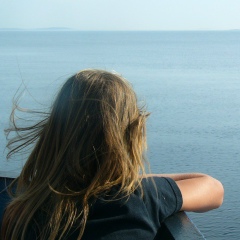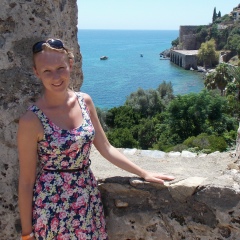Среди переплетения ризоидов, в щелях между камнями и в других естественных укрытиях встречаются два вида многощетинковых червей – нереис. В отличие от многих других червей, у нереисов хорошо развита кровеносная система. Головной отдел червя устроен сложно, имеет глаза и несколько пар чувствительных выростов, с помощью которых он ориентируется под водой. Особенно интересен многощетинковый червь, близкий родственник широко известного палоло, нереида зеленая (Nereis virens).
В Белом море он был впервые обнаружен перед самой войной и его сложный жизненный цикл до конца еще не расшифрован. В течение своей жизни нереис обитает то на литорали, то спускается в сублитораль, где держится на плотных поселениях мидий. Он всегда ведет довольно скрытый образ жизни и найти его бывает не так-то легко. Но вот приходит время размножения. Ночью, в новолуние, половозрелые экземпляры, достигающие иногда 60 см в длину, всплывают к поверхности в несметном количестве и начинают брачный танец. Это – поистине захватывающее зрелище. В тихие ночные часы приполярного лета тысячи животных, похожих на блестящие сине-зеленоватые шелковые ленты, бороздят зеркально-спокойную гладь моря, слегка приподняв над поверхностью воды передний конец тела. Через небольшие разрывы стенки тела из них текут мутноватые ручейки икры и молок. Роение нереисов – время великого пира чаек, с криком носящихся над морем и выхватывающих из него лакомую добычу. В неменьшей степени пирует и треска. Еще несколько дней она не будет ловиться на спиннинг. Два или три дня продолжается эта «свадьба», приуроченная к последнему новолунию июня, или к первому – июля. Это явление получило название «пляски смерти» нереис, т.к. после выхода половых продуктов в море черви погибают.
Связь с лунным циклом и массовое роение ставят эти животные еще ближе к тихоокеанскому палоло. Справедливости ради надо отметить, что так же, как и его полинезийский собрат, беломорский червь и съедобен, и вкусен.
Интересно, что поморы давно знали червя и называли его морским змеем. Змеи эти даже фигурируют в старинной легенде о беломорском святом Варлааме Керетском, который жил в XVI веке.
В Белом море он был впервые обнаружен перед самой войной и его сложный жизненный цикл до конца еще не расшифрован. В течение своей жизни нереис обитает то на литорали, то спускается в сублитораль, где держится на плотных поселениях мидий. Он всегда ведет довольно скрытый образ жизни и найти его бывает не так-то легко. Но вот приходит время размножения. Ночью, в новолуние, половозрелые экземпляры, достигающие иногда 60 см в длину, всплывают к поверхности в несметном количестве и начинают брачный танец. Это – поистине захватывающее зрелище. В тихие ночные часы приполярного лета тысячи животных, похожих на блестящие сине-зеленоватые шелковые ленты, бороздят зеркально-спокойную гладь моря, слегка приподняв над поверхностью воды передний конец тела. Через небольшие разрывы стенки тела из них текут мутноватые ручейки икры и молок. Роение нереисов – время великого пира чаек, с криком носящихся над морем и выхватывающих из него лакомую добычу. В неменьшей степени пирует и треска. Еще несколько дней она не будет ловиться на спиннинг. Два или три дня продолжается эта «свадьба», приуроченная к последнему новолунию июня, или к первому – июля. Это явление получило название «пляски смерти» нереис, т.к. после выхода половых продуктов в море черви погибают.
Связь с лунным циклом и массовое роение ставят эти животные еще ближе к тихоокеанскому палоло. Справедливости ради надо отметить, что так же, как и его полинезийский собрат, беломорский червь и съедобен, и вкусен.
Интересно, что поморы давно знали червя и называли его морским змеем. Змеи эти даже фигурируют в старинной легенде о беломорском святом Варлааме Керетском, который жил в XVI веке.
Among the interlacing of rhizoids, in the gaps between the stones and in other natural shelters, there are two types of polychaete worms - nereis. Unlike many other worms, nereis have a well-developed blood system. The head section of the worm is complex, it has eyes and several pairs of sensitive outgrowths, with the help of which it orients itself under water. Of particular interest is the polychaemal worm, a close relative of the widely known palolo, the nereid green (Nereis virens).
In the White Sea, it was first discovered just before the war itself, and its complex life cycle has not yet been fully deciphered. During its life, Nereis dwells either in the littoral zone, then descends into the sublittoral zone, where it rests on dense mussel populations. He always leads a rather hidden lifestyle and it is not so easy to find him. But here comes the breeding time. At night, on a new moon, sexually mature specimens, sometimes reaching 60 cm in length, float to the surface in infinite quantities and begin a mating dance. This is a truly spectacular sight. During the quiet night hours of the polar summer, thousands of animals resembling brilliant blue-greenish silk ribbons plow the mirror-calm expanse of the sea, slightly lifting the front end of the body above the surface of the water. Through the small ruptures of the body wall, unclear streams of caviar and milt flow from them. The swarming of the Nereis is the time of the great feast of the seagulls, screaming about the sea and snatching tasty prey from it. Cod is also no less a feast. For several more days she will not be caught spinning. Two or three days this “wedding” continues, timed to coincide with the last new moon of June, or the first - July. This phenomenon was called the "dance of death" Nereis, because after the release of sexual products in the sea, the worms die.
The connection to the lunar cycle and mass swarming put these animals even closer to the Pacific Palolo. In fairness it should be noted that, just like its Polynesian counterpart, the White Sea worm is both edible and tasty.
Interestingly, the Pomors have long known the worm and called it a sea serpent. These snakes even appear in the old legend of the White Sea St. Varlaam Keretsky, who lived in the XVI century.
In the White Sea, it was first discovered just before the war itself, and its complex life cycle has not yet been fully deciphered. During its life, Nereis dwells either in the littoral zone, then descends into the sublittoral zone, where it rests on dense mussel populations. He always leads a rather hidden lifestyle and it is not so easy to find him. But here comes the breeding time. At night, on a new moon, sexually mature specimens, sometimes reaching 60 cm in length, float to the surface in infinite quantities and begin a mating dance. This is a truly spectacular sight. During the quiet night hours of the polar summer, thousands of animals resembling brilliant blue-greenish silk ribbons plow the mirror-calm expanse of the sea, slightly lifting the front end of the body above the surface of the water. Through the small ruptures of the body wall, unclear streams of caviar and milt flow from them. The swarming of the Nereis is the time of the great feast of the seagulls, screaming about the sea and snatching tasty prey from it. Cod is also no less a feast. For several more days she will not be caught spinning. Two or three days this “wedding” continues, timed to coincide with the last new moon of June, or the first - July. This phenomenon was called the "dance of death" Nereis, because after the release of sexual products in the sea, the worms die.
The connection to the lunar cycle and mass swarming put these animals even closer to the Pacific Palolo. In fairness it should be noted that, just like its Polynesian counterpart, the White Sea worm is both edible and tasty.
Interestingly, the Pomors have long known the worm and called it a sea serpent. These snakes even appear in the old legend of the White Sea St. Varlaam Keretsky, who lived in the XVI century.
У записи 2 лайков,
0 репостов.
0 репостов.
Эту запись оставил(а) на своей стене Мария Соболева






















